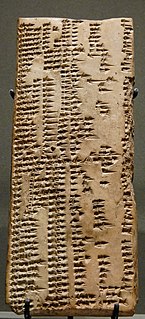 W
WThe Agušaya Hymn or Song of Agušaya is an Old Babylonian literary work, a “song of praise”, written in the Akkadian language concerning the goddess Ištar, identified with the serpent deity Irnina. It may have been called “the Snake has Turned” in antiquity, as it has ú-ta-ar MUŠ inscribed at the top edge at the beginning. It is extant on two unprovenanced tablets, designated A and B, the latter of which includes a request for eternal life for king Hammurabi, on the fifth column, 26th line, for whom it is thought to have been composed as an epic hymn of celebration of “the mad dancer in battle”. It is arranged into ten kirugú-stanzas and six ĝešgiĝal-antiphons as lyrical retorts, the numbering of which suggest that the work extends over the two tablets, although the second may not be the actual sequel of the first as the first is an eight column tablet while the second only has six columns and there are apparently subtle differences in late Old Babylonian cursive cuneiform distinguishing them, suggesting tablet A is the younger copy.
 W
WThe Amarna letters are an archive, written on clay tablets, primarily consisting of diplomatic correspondence between the Egyptian administration and its representatives in Canaan and Amurru, or neighboring kingdom leaders, during the New Kingdom, between c. 1360–1332 BC. The letters were found in Upper Egypt at el-Amarna, the modern name for the ancient Egyptian capital of Akhetaten, founded by pharaoh Akhenaten (1350s–1330s BC) during the Eighteenth Dynasty of Egypt. The Amarna letters are unusual in Egyptological research, because they are mostly written in a script known as Akkadian cuneiform, the writing system of ancient Mesopotamia, rather than that of ancient Egypt, and the language used has sometimes been characterised as a mixed language, Canaanite-Akkadian. The written correspondence spans a period of at most thirty years.
 W
WAtra-Hasis is an 18th-century BCE Akkadian epic, recorded in various versions on clay tablets, named for its protagonist, Atrahasis. The Atra-Hasis tablets include both a creation myth and one of three surviving Babylonian flood myths. The name "Atra-Hasis" also appears, as king of Shuruppak in the times before a flood, on one of the Sumerian King Lists.
 W
WThe Dialogue between a Man and His God is the earliest known text to address the answer to the question of why a god permits evil, or theodicy, a reflection on human suffering. It is a piece of Wisdom Literature extant on a single clay cuneiform tablet written in Akkadian and attributed to Kalbanum, on the last line, an individual otherwise unknown. It is dated to the latter part of the Old Babylonian period, around about the reign of Ammi-Ditana according to Lambert, and is currently housed in the Louvre Museum, accession number AO 4462. It is of unknown provenance as it was purchased from an antiquities dealer by the Museum in 1906. It shares much of its style with an earlier Sumerian work, “Man and His God”, a penitential prayer of the UR III period.
 W
WThe Enūma Eliš is the Babylonian creation myth. It was recovered by English archaeologist Austen Henry Layard in 1849 in the ruined Library of Ashurbanipal at Nineveh. A form of the myth was first published by English Assyriologist George Smith in 1876; active research and further excavations led to near completion of the texts and improved translation.
 W
WThe concept of a garden of the gods or a divine paradise may have originated in Sumer. The concept of this home of the immortals was later handed down to the Babylonians, who conquered Sumer.
 W
WThe Kelashin Stele found in Kelashin, Iraq, bears an important Urartian-Assyrian bilingual text dating to c. 800 BC, first described by Friedrich Eduard Schulz in 1827. Part of Schulz's notes were lost when he was killed by Kurdish "bandits", and later expeditions were either prevented by weather conditions or Kurdish brigands, so that a copy of the inscription could only be made in 1951 by G. Cameron, and again in 1976 by an Italian party under heavy military protection.
 W
WThe cuneiform lexical lists are a series of ancient Mesopotamian glossaries which preserve the semantics of Sumerograms, their phonetic value and their Akkadian or other language equivalents. They are the oldest literary texts from Mesopotamia and one of the most widespread genres in the ancient Near East. Wherever cuneiform tablets have been uncovered, inside Iraq or in the wider Middle East, these lists have been discovered.
 W
WLudlul bēl nēmeqi, also sometimes known in English as The Poem of the Righteous Sufferer, is a Mesopotamian poem written in Akkadian that concerns itself with the problem of the unjust suffering of an afflicted man, named Šubši-mašrâ-Šakkan (Shubshi-meshre-Shakkan). The author is tormented, but he does not know why. He has been faithful in all of his duties to the gods. He speculates that perhaps what is good to man is evil to the gods and vice versa. He is ultimately delivered from his sufferings. It is thought to have been composed during the reign of Kassite king of Babylon Nazi-Maruttaš, who is mentioned on line 105 of tablet IV.
 W
WThe Maqlû, “burning,” series is an Akkadian incantation text which concerns the performance of a rather lengthy anti-witchcraft, or kišpū, ritual. In its mature form, probably composed in the early first millennium BC, it comprises eight tablets of nearly a hundred incantations and a ritual tablet, giving incipits and directions for the ceremony. This was performed over the course of a single night in the month of Abu (July/August) when the perambulations of the spirits to and from the netherworld made them especially vulnerable to its spells. It was the subject of a letter from the exorcist Nabû-nādin-šumi and the Assyrian king Esarhaddon. It seems to have evolved from an earlier short-form with only ten incantations to be performed in a morning ceremony, whose first incantation begins: Šamaš annûtu șalmū ēpišiya.